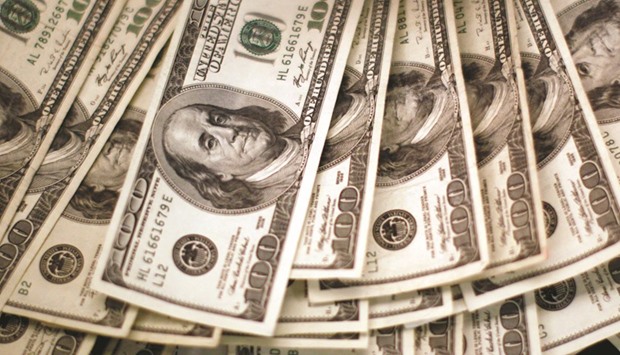Donald Trump’s plans for a US construction boom have set off a chain reaction that’s invigorated commodities prices, hammered bonds, buttressed the dollar and is now ripping into emerging markets.
Copper extended the biggest weekly advance in at least three decades in London. That’s boosting the outlook for inflation, causing the rout in bonds to deepen in Europe after more than $1tn was erased from the value of global debt market. Rising Treasury yields are driving the Bloomberg Dollar Spot Index to the highest since February, leading to the worst three-day selloff in five years for developing-world currencies, which caused central banks to intervene. European stocks pared their best weekly jump since July and S&P 500 Index futures fell.
The dollar’s rally since Trump’s surprise win in Tuesday’s vote is causing turmoil in emerging markets, prompting Malaysia’s central bank to say it may act at times of extreme volatility, while India and Indonesia were said to have supported their currencies on Friday. While metals have rallied on pledges to boost construction of roads, airports and bridges, vows to renegotiate the North Atlantic Treaty Agreement and talk of tariffs on China have weighed on the outlook for developing economies.
“It’s a cascade of events,” said Per Hammarlund, the chief emerging-market strategist at SEB in Stockholm. “It’s a big risk-off event for emerging markets. The green shoots, primarily faster growth, that we have seen this year are at risk if Trump tears up NAFTA and slaps punitive tariffs on China. Those policies will cause inflation and US interest rates to rise, which in turn will pull capital out of emerging markets.” Nickel set for biggest weekly increase since April 2009. Dow Jones Industrial Average reaches record on Thursday. Gold is heading for worst week in a month. Stoxx Europe 600 Index set for best week since July. Largest increase in 30-year Treasury yields since 2009. Italian bonds are poised for worst three-week selloff since 2011. Emerging-market stocks set for biggest three-day slide since August 2015. Mexico’s peso plunges 13% in three days.
Traders are buying copper like never before in what Citigroup says may be a premature rally driven partly by Chinese speculators. The metal is poised for a 19% gain this week, the biggest advance since records begin in 1986. Prices rose 5.7% to $5,919 a metric tonne in New York. Nickel was on track for a weekly gain of 14%, the biggest in more than seven years.
Gold fell as the dollar rose amid increasing speculation the US economy will improve and interest rates will increase. Bullion for immediate delivery has fallen 3.7% last week to $1,256.41 an ounce, confounding predictions that a Trump presidency would create a powerful rationale for investing in the haven.
Oil was back where it started the week as swings driven by US offset doubts about whether Opec can finalise the Algiers deal to cut production. West Texas Intermediate dropped 1.4% Friday to $44.04 a barrel and Brent lost 1.1% to $45.36.
European government bonds extended their selloff on Friday. Benchmark German 10-year bunds declined for a fifth consecutive day, pushing the yield to the highest since February. Italy’s 10-year bond yield climbed above 2% for the first time since September 2015.
The yield on similar-maturity UK gilts climbed to 1.42%, the highest since before the nation’s vote to leave the European Union. Yields on US 30-year bonds, which are more sensitive than shorter maturities to the outlook for inflation, have jumped almost 40 basis points since last Friday and a $15bn auction of the tenor on Thursday showed waning appetite for the securities.
The Bloomberg Barclays US Treasury Index slid 1.85% last week, its biggest loss since 2009. Treasury markets were closed yesterday.
The capitalisation of a global bond market index slid by $450bn on Thursday, a fourth day of declines that pushed the week’s total above $1tn for only the second time in two decades, Bank of America Merrill Lynch data show. Global stocks gained $1.3tn in the same period.
The MSCI Emerging Markets Currency Index fell 1.1% and is down 2.8% in three days. Mexico’s peso has led declines, sinking 13% since Tuesday, followed by a 9.1% slide in Brazil’s real and an 8.3% drop in South Africa’s rand.
In Asia, Indonesia’s rupiah and South Korea’s won sank to their weakest levels in more than four months and Malaysia’s ringgit dropped to the lowest level since January.
“Rising US yields will cause volatility in capital flows into emerging markets, and with the Fed still likely to hike rates in December, the risk is for further outflows,” said Khoon Goh, head of Asian research at Australia & New Zealand Banking Group Ltd in Singapore, referring the Federal Reserve. Trump’s plan to revisit trade agreements “is also a factor,” he said.
Latin American currencies have tumbled on concern Trump’s administration could usher in a host of protectionist measures. A trade war would be a blow to economies such as Mexico, which gets 80% of its overseas sales from the US.
Trump’s victory produced an unlikely winner in the pound, which has climbed against all 31 of its major peers this week. The euro, meanwhile, has plunged, falling 2.6% against the dollar in its worst week since October 2015.
The Bloomberg Dollar Spot Index climbed 2.7% in the period, the best performance since September 2011.
The MSCI Emerging Markets Index dropped 2.4% and is down 5.3% in three days. By contrast shares in Europe are poised for their best week since May and US stocks advanced for a fourth day on Thursday in the longest run of gains since July.
“There’s been a big rotation out of emerging markets into US dollar assets,” said Jeffrey Halley, a market strategist at Oanda Asia Pacific in Singapore. “An emerging market is a market you can’t emerge from in an emergency. It’s one of the best lessons I’ve ever learnt in 30 years in the market. When everybody runs for the door at the same time, the door’s very small.”
On Friday, the Stoxx Europe 600 Index slipped 0.3% as metal producers pulled back from the highest level since June 2015. The Stoxx 600 mining gauge’s relative strength index signalled the shares were the most overbought in 10 years.

The dollar’s rally since Trump’s surprise win in Tuesday’s vote is causing turmoil in emerging markets, prompting Malaysia’s central bank to say it may act at times of extreme volatility, while India and Indonesia were said to have supported their currencies on Friday.


